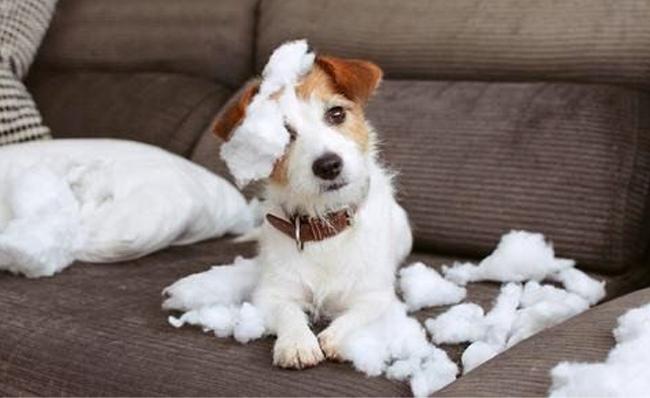Happy Dog by Bryan Litchford CPDT-KA, owner of PCD TRAINING, and author of the book Excuse Me Sir… Do You Speak Dog?
Help my dog ate my couch!
I don’t think there is a week that goes by that I don’t get a phone call from a frantic dog owner crying foul. My dog ate my couch, my dog destroyed my backyard, my dog scattered the trash or my dog barks non stop. Although there can be numerous reasons for these behaviors and numerous solutions, in this post, I am going to focus on what I consider the most common issue: boredom.
Try to imagine the life of a dog. It’s basically a life of waiting. Waiting for their owner to take them out to pee, waiting to be fed, waiting to go for a walk, and waiting for someone to play with them.
When I ask clients what they do when their dog seems bored, the most common response I get is, “I let them run around in the backyard.” Let’s look at that from the dog’s perspective. What does the dog get out of going out to the backyard alone? Is there something different this time than there was the last 100 times? Same grass, same trees, same fence. What’s entertaining about that? What would you do if you were a dog? Dig? Chew up the lawn furniture? Bark at the people walking by? What would we as humans do in that scenario? I for one would go stir crazy. I understand that we have busy lives, but we have to remember that having a dog comes with responsibility. Not just to feed them and take them out to pee, but to make sure they are happy and mentally stimulated. And it might just save your lawn furniture.
All dogs from the tiniest toy breed to the Irish Wolfhound have a certain set of skills that are built in. These skills are part of what makes them dogs. They use their nose to find their prey, chase it down, and finally, dissect and eat their prey. Dogs no longer need these skills since hitching their wagon to ours. Nevertheless they still exist. Herein lies the rub. Whether chasing a bird or a bicycle, dissecting a squirrel or a pillow, or scenting down a rabbit on a hunt or while on leash, to the dog it’s all the same. When a dog gets bored, often these are the behaviors they fall back on.
The great news is if we give them human-appropriate outlets for these behaviors it can solve a lot of our issues. This is called “enrichment.”
Enrichment for a Happy Dog
So let’s explore ways we can help our dogs live more enriching lives. Dogs have been bred for thousands of years to be social and work alongside humans. This means that although some of the suggestions here will be for when your dog is alone, enrichment efforts really should include human interaction whenever possible. Not only will this work to keep your dog mentally stimulated, it will also help in engagement activities and obedience necessities like coming when called.
Toys
There are many kinds of dog toys. Let’s break them up into a few categories and explore the best ways to use them.
1. Dental toys – these are for helping to keep your dogs teeth clean between brushing, for teething puppies, and can also be used to alleviate boredom. These are a must-have. Especially for puppies! Chewing helps elevate the pain of teething, and freezing them makes them even more soothing. These should be made available at all times. If your dog is not interested in chewing on them, you may need to entice them by rubbing peanut butter or some other tasty spread on them. If there are knobs or grooves on the toy, rub the spread into the grooves so that it’s a little more difficult to get off. If the toy is smooth like a nylabone you may need to ruff up one end with some coarse sandpaper or a file before rubbing it down with the treat. Dogs love the gnarly feeling of a toy or bone that has been chewed on. Many puppies will continue chewing once they get the food off because of the way it feels.
2. Rubber chew toys such as a Kong – As with dental toys, these can help to relieve boredom by giving your dog something to chew. You can stuff them with treats to encourage chewing on them or even feed their meals in them. Place their kibble in a bowl and moisten it with canned food, warm water, or low sodium chicken stock. Stuff the Kong, and give it to your dog at meal time. When they become skilled at getting the food out, try freezing it before giving it to them. Remember, those skills that dogs are born with need an outlet. Giving them a Kong filled with their meal is a great way to fulfill it! The benefit for us is it takes time for them to eat which in turn gives us a break. Over time dogs learn to love chewing on their Kong, and there’s a good chance they will choose to chew on it any time they get bored. They are also great for a game of fetch. They bounce erratically, so it’s more fun for your dog to chase.
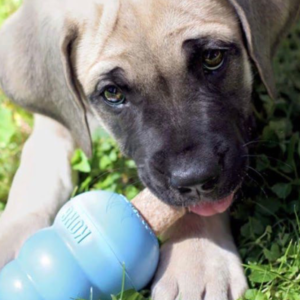
3. Interactive toys like tug ropes, flirt poles, balls and frisbees – These are my personal favorite because they involve playing with your dog. It’s a proven fact that when dogs or even human kids, are enjoying the learning process, they learn much faster and retain what they have learned. So I tend to reinforce behaviors I want to grow with play. Example: I ask the dog to sit, and when he sits, I reward him with a game of tug, frisbee or fetch. Interactive toys should be put away and only brought out when you can be a part of the game. By doing this, the game is much more reinforcing to the dog, and it builds a bond between you and your dog. It’s not about the toy. It’s about you! Your dog will learn that the really awesome stuff in life is available through interaction with you. You will become the greatest thing in the world to your dog which is great when you need him to focus on you and not that cat that is strolling by.
4. Plush toys – These toys are perhaps the most misunderstood. Countless dog owners message me in a panic that their dog is becoming aggressive. Citing that they bought their dog a cute little stuffed bunny and it was destroyed in seconds. Not only is this normal but also healthy behavior. Their dog is just being a dog. Again this is just instinct that is built into the dog. It’s part of their prey drive. As long as your dog is closely supervised while doing this, paying close attention that they do not swallow any of the pieces, it’s a great outlet for this behavior. It sure beats the same thing happening to your couch pillows. For this reason, plush toys should be put away when you are not actively watching your dog.
5. Puzzle toys – It’s truly amazing watching a dog when they are engaged with a puzzle toy. And the more variety you offer them, the better they get at solving them. These toys use food, and the dog has to figure out how to access it. There are numerous versions which you can purchase through your favorite online retailer, local pet store or big box store. You can also make your own. YouTube is a great resource for this. Just search enrichment for dogs, and you will find hours of video on how to make them.
Walks
Taking a walk is always a favorite enrichment activity for dogs, especially if you understand that it’s not just about exercise. It’s also about exploration and taking in the sights and smells. Even a large yard, and access to the whole house, can become confining. Walking in different neighborhoods, parks, and public spaces can exercise your dogs mind and body. The only caveat is that your dog understands how the walk works and does not drag you down the road. That is not fun for anyone. I recommend contacting your local trainer for help with this.
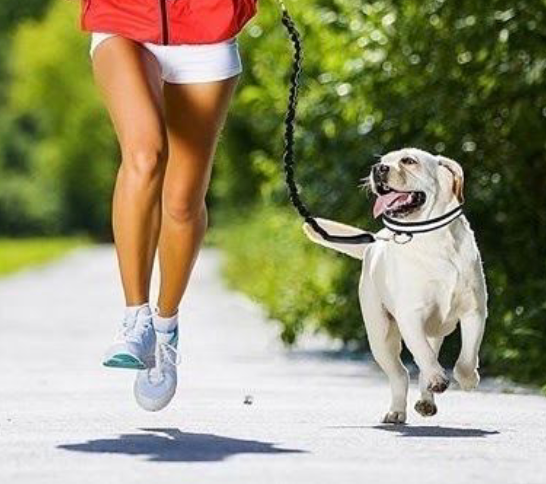
Scent Games
Your dog’s nose is possibly their most used sense. It is how they take in the world around them. Taking advantage of their desire to sniff everything by teaching them tasks that use their nose is one of the best ways you can enrich your dog’s life. Here are some ideas to entertain your dog with their nose.
1. Scatter their meal in the grass and let them forage for it – Use the cue “go find it” as you scatter the kibble. Eventually, scatter the food before you let her outside. Then say, “go find it,” as you let her out. By doing this, you are teaching her to search when she hears the cue. Once this behavior is established, it can be useful in other situations such as a walk when you need her focus to be on something other than the squirrel running across the road. Dachshunds absolutely loves this!
2. Treat trail – This is similar to the scatter game above, but instead of scattering the treats, you put them in a line leading to a big jackpot at the end. It’s important to play the scatter game first so they understand the “go find it” cue. Guide them to the first treat in the line, and say the cue.
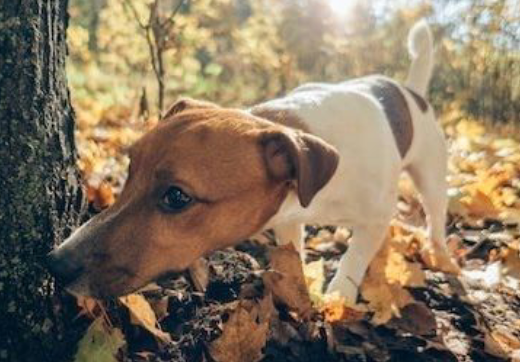
3. Hide treats around the house– This is a great game to play when the weather outside is bad. With someone restraining your dog, give them one treat, and then “hide” a few around the room as the dog watches. Make it really easy at first. Place them in plain sight. Release the dog, and say “go find it.” After several reps of this, place more treats, but make it slightly more difficult. Even if your dog is watching, it is unlikely that they will remember where they were all placed. After picking up one or two, they will start to rely on their nose. Continue this by making it harder and harder to find the treat. Eventually block the dog outside of the room while you hide the treats, so the dog can’t see where they were hidden. Release the dog, and say the cue “go find it.” I would recommend making them a little easier to find at this stage until they get the hang of it. When they find the treats, make a big deal of it with lots of excited praise.
4. Hide a stuffed Kong – This one is great if you are going to be gone for a little bit. To begin, practice the exercise above in order to teach them the “go find it” cue. After they understand the cue, hide a stuffed Kong or two, perhaps with their meal, and give them the cue. The first few times you do this, don’t leave. Make it fairly easy for them to find, gradually making it more difficult.
5. Play the shell game – Gather several plastic easter eggs, Solo cups or small bowls that all look alike. With your dog present, hide a treat under one of the items. Make sure your dog is watching. Say “find it,” and let your dog push over the object to get to the treat. Next, toss a treat across the room for your dog to retrieve. While he is away, hide a treat under one of the items, and shuffle it in with the other like items. When he returns, say “find it.” When he finds it, give high praise and toss another treat.
6. The toilet paper roll game – This is great for a dog with little experience searching for treats. Save several empty toilet paper rolls (10 or 20). Place them standing up in a small box. Hide a few treats in the bottom of the box and say the cue “find it,” and let him search the box for the treats. Note: these games are a great foundation for learning scent work for dog sports!
Dog sports
Over the past decade dog sports have gotten more and more popular! There has never been a better opportunity to get your dog involved, and there is something for almost any dog. Here is a list of popular dog sports. It is by no means exhaustive, in fact it is just the tip of the iceberg: Schutzhund, Barn Hunts, Scent Work, Rally Obedience, Treibball, Dock Jumping, Competition Obedience, Agility, Dog Parkour, Disk Dog, Flyball, Musical Canine Freestyle, Mondioring, Conformation Showing and much more!
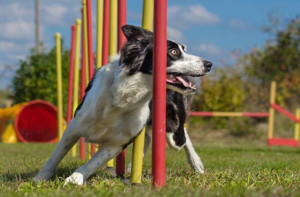
Training
Training is perhaps the most mutually beneficial enrichment of all. If done correctly with an emphasis on positive reinforcement and building a relationship between the dog and human, there is nothing more rewarding. I have owned dogs my whole life, and I loved every one of them. However, until I learned how to really train instead of just forcing my dogs to comply with my wishes, I was clueless of the bond that could be possible. The subject of training is a really big subject and much too broad for the scope of this paper. My suggestion is to do your homework. Find a certified professional dog trainer. A great place to start is by contacting CCPDT, IAABC, PPG, KPA or another professional dog training organization who puts a priority on humane, ethical and science based training. They should be able to connect you to certified trainers in your area. Once you find a trainer, ask questions like: What training techniques and tools do you use? Are you a certified professional dog trainer? Are you required to do continuing education to maintain your certification? Do you have references?
Please remember, training is not something that should be taken lightly. Dogs are sentient beings with emotions very similar to humans. In the wrong hands there can sometimes be serious emotional and psychological damage done to your dog. Done right, it can be the greatest gift you could ever give them.
Conclusion
Enrichment is not about one thing. It’s about giving your dog variety and novelty. So mix it up! You might just be amazed at how much better your dog acts when you give them the focus and attention they so desperately need.
About the Author
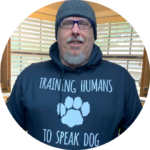 Bryan Litchford is a resident of Van Buren, Arkansas, and has had an interest in training dogs since he was a teenager. Once he began studying dog behavior, he became fascinated with the science of training. He soon made the decision to train professionally. He became a member of The Association of Professional Dog Trainers, and after taking some courses in dog training and working as a behavior and training consultant volunteer at a local dog shelter, he took the exam to become a CPDT-KA (Certified Professional Dog Trainer). He strives to always train using force-free, science-based training methods that are ethical and healthy for the dog and easy for the dog owner. He is committed to continuing education to stay current on the latest science and best practices of dog training..
Bryan Litchford is a resident of Van Buren, Arkansas, and has had an interest in training dogs since he was a teenager. Once he began studying dog behavior, he became fascinated with the science of training. He soon made the decision to train professionally. He became a member of The Association of Professional Dog Trainers, and after taking some courses in dog training and working as a behavior and training consultant volunteer at a local dog shelter, he took the exam to become a CPDT-KA (Certified Professional Dog Trainer). He strives to always train using force-free, science-based training methods that are ethical and healthy for the dog and easy for the dog owner. He is committed to continuing education to stay current on the latest science and best practices of dog training..

